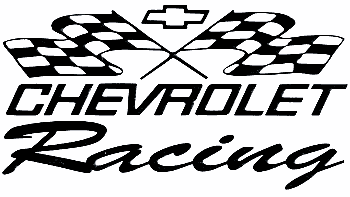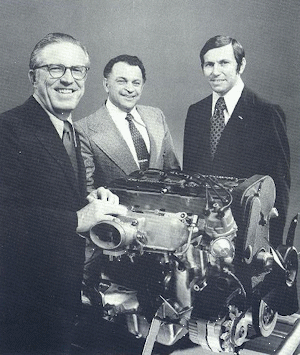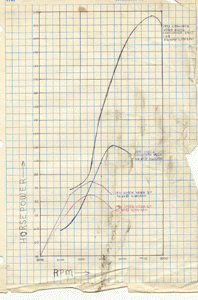Dark Blue Metallic 35
The 1974 single throttle body engine along with: Donald H. McPherson, Chevrolet's Chief Engineer; Cal Wade, the engine designer; and Lloyd E. Reuss, the Vega Cosworth Chief Engineer. (Left to right)
By the Fall of 1970 Cosworth received the first fully machined pre-production blocks from Chevrolet, and by March of 1971 the first experimental EAA unit roared to life on Cosworth of England's dynamometer in Northampton, producing what was referred to as "useful" horsepower.
Meanwhile, in Detroit a disappointing launch of the stock Vega during the fall of 1970, worsened by a 2 month strike, saw sales of the inaugural 1971 Vega languish. It quickly became obvious that the American public hardly appreciated the groundbreaking technology of the Vega's die-cast lightweight aluminum block. It also became obvious that the Vega GT lacked the panache to bolster the standard Vega's disappointing sales.
The pressure on Cal Wade and Cosworth of England to deliver quickly increased exponentially. During the year that followed, as Cosworth of England experienced repeated catastrophic failures of the engine blocks, they had an unhealthy propensity to split horizontally below the cylinder bores. Chevrolet pursued a diverging path toward a streetable version of the twin cam cylinder head design, seeking a reliable engine that developed gobs of power. Lloyd Reuss, (today) (profile), then Assistant Chief Engineer at Chevrolet, decided that a streetable version of the Cosworth engine would be the hot ticket to improving the Vega's image and Chevrolet's sporting image as well. He hoped to produce the reciprocating heart of a street fighter capable of dueling with the BMW\;s of the day on more than equal terms.
Mechanix Illustrated, August 1973
The Cosworth Vega was thus conceived as a complete sports sedan: high performance engine, high performance chassis, unique outward appearance. It was to be introduced in 1974. Efforts to bring the horsepower developed by the EAA engine to the street, though initially promising, were slowly strangled by the twin hands of corporate average fuel economy (CAF) requirements and EPA emissions standards.
The Cosworth Vega History
Deep within the Chevrolet Motor Division lurks a department known simply as the "Special Products Group". Formerly known as "Product Promotion", it is really the Chevrolet Racing Department by another name. Similar in nature to Lockheed's famed Skunk Works, the Group evolves production engines and vehicles for racing applications and develops special enthusiast versions of production automobiles and engines, all in an effort to boost sales and enhance the image of Chevrolet. Notably successful over the years, the Group has given Chevrolet a reputation for innovation and performance.

One need only consider a few of Chevrolet's outstanding successes to appreciate the work of this Group: America's first sports car, the Corvette; the now legendary 1967-1969 Z/28 Camaro with its smaller, higher revving, high output racing engine; America's first rear-engined sports sedan, the Corvair; the turbocharged Corvair Monza Spyder; the 1968 L88 and 1970 LT-1 Corvette engine; and the ZR-1 Corvette.
Today we can proudly add to this list the 1975-1976 Cosworth Vega.
Humble in its origins, it has endeared itself to the hearts and minds of a small but loyal following. Though often touted as a highly collectible car, it has yet to attain cult status, or to make its owners wealthy. What it has done, however, is bring together via the Cosworth Vega Owners Association , a Facebook group Cosworth Vega Owners, and the Yahoo! cosworthvegas Board as diverse a collection of owners as could ever be imagined.
This History Is For Them
In 1969 General Motors Chairman James Roche * announced plans to combat the rising tide of imports with a small, stylish, economical vehicle more suited to American tastes.
Designed by GM Central's corporate engineers, the Vega fell to Chevrolet for manufacture and sale. GM VP and Chevrolet General Manager John Delorean immediately recognized the value of and the need for an image booster for the new kid on the block.
He memoed Jim Musser, suggesting that he contact Keith Duckworth at Formula One engine builder Cosworth Engineering, Ltd. to see if they might be interested in the new technology/high silicon content Vega engine block for use as a four- cylinder racing engine.
* Business Week Magazine: 1968's Highest-Paid Executive:
James M. Roche
Chairman, General Motors
$795,000
Dow Jones Average: 943.75
Average Worker Pay: $5,602
Intrigued by the idea and recognizing the value of an association with Chevrolet, Keith Duckworth considered the proposal an attractive way to build a racing engine. He promptly visited the States to examine the new Vega block closely. Impressed by its sound structural concepts and logical lines of stress from top to bottom, he was overheard to say, "You couldn't easily see where it was likely to break first." Duckworth decided that Cosworth was interested, and a dialog with Chevrolet's engineers began in 1969.

Initially drawn with a compression ratio of 12:1, a fat fuel curve, and a need for Sunoco 260, the engine design suffered from repeated compromises as emissions standards tightened, the fuel crisis hit and continued, and leaded high octane fuel trickled down the trail of the dinosaurs. The designers ratcheted down the CR first to 11.25:1, then to 10.5:1, then even further to a weak 9.5:1, and finally all the way down to a nominal (and optimistic) 8.5:1, abandoning along the way porting and polishing of the cylinder head and several other hot rod tricks.
Horsepower plummeted from the 185 HP level quoted in 1971, to less than 130 HP reported internally on May 1, 1973, back up to 135 SAE net HP on July 23, 1973 (though 140 HP was reported in the August, 1973 issue of Car and Driver, an apparently wishful number), before the bottom fell out by the time of production in 1975 when the rating plunged to 110 HP in street trim. In April of 1973 the first Cosworth Pilot Program was conducted at Ste. Therese, Quebec Assembly Plant. The Lordstown plant was down, due to a strike at the adjacent Fisher Body Stamping Plant. Seven Cosworths, painted Neutral Silver, were built for Engineering testing.
Desperate to bolster Vega sales and despairing of ever achieving a boost from racing success due to continuing durability problems with the standard block, Chevrolet Public Relations began a campaign to tantalize the public with official releases of data on the Cosworth Twin Cam engine and the planned limited edition Cosworth Vega model of the standard Vega in an effort to hype interest and boost flagging sales. These releases began in March of 1973 and led to a major announcement on July 23, 1973. By that later date the car's exterior color had been revised to black with gold striping, essentially as we see the car today. According to the press releases, "the Cosworth Vega is a highly sophisticated sports concept designed to generate excitement and bolster interest in the G.M. domestic small car market". It added further, "another marketing objective is to establish the design superiority and engineering excellence of (this) Vega option in the minds of knowledgeable enthusiasts."
This option was designated RPO (regular production option) Z/09. In an effort to boost its desirability quotient, Chevrolet decided to allow production of only 5000 units. As there were more than 5000 Chevy dealers, allocation became an issue. To become an "Authorized Cosworth Dealer", a dealership had to agree to invest in mandatory tools, mechanic training and a stock of Cosworth specific parts. Only the highest volume dealers who agreed were admitted to the program and promised a car.
Detail showing (RPO) Z09 from "Passenger Car Prices - Page 41" January, 1976 General Motors, Chevrolet Division
Many qualifying dealers began accepting waiting list deposits in 1973 for the planned 1974 model. Unfortunately, emissions testing proved to be the Achilles heel of the new engine. In April of 1974, just one month before the planned introduction, two of the three engines in the Emissions Certification test cars burned exhaust valves by the 46,000-mile mark, just before reaching the 50,000 mile limit (PDF) marking the end of the test. The third car was withdrawn from testing and a teardown of its engine revealed incipient exhaust valve damage as well. Bill Howell, of Chevrolet Product Promotion (aka Chevrolet Racing) and a fellow Cosworth owner, who together with Herb Fishel spent hundreds of dyno hours developing Chevrolet's version of the Cosworth Twin Cam engine, twice criticized the decision that led to this failure.
In a rare moment of candor, when among a small group of Cosworth Vega enthusiasts in Akron, Ohio, he attributed the emissions test failure debacle to an irrational decision to run the timing substantially retarded on the test cars in an effort to provide a safety margin in the emissions numbers. That decision, which he had strenuously but unsuccessfully opposed, made absolutely no sense to him, and left him bitter. As he predicted, it dumped excessive heat into the exhaust valves and seats, and they predictably failed. He was convinced from all of his dyno work on the engines, and based upon all of the knowledge he had amassed during his impressive career, that they would have passed emissions with the timing properly advanced.

Two years later, when addressing the first ever Roundup of Cosworth owners in Clarksville, TN, he again explained the cause of the failure, but on this occasion chose to omit the placing of blame.
With the planned 1974 production of the Cosworth Vega scrapped, and its introduction postponed until April of 1975, numerous changes were made, not the least of which involved advancing the timing. However, the most apparent change was the aforementioned change in color. John Delorean decreed that henceforth all Cosworths would be black and accented with gold. In the first week of February of 1975, the Lordstown plant built five Cosworth Pilot units. By the end of that week two emissions Certification cars coincidentally and successfully completed the grueling 50,000-mile, two and one-half month, EPA certification ordeal. The following month the EPA notified Chevrolet that the Cosworth's emissions certification Certificate wwould be issued on the 25th of March. The first salable unit was then built on March 27, 1975. Three weeks later, on April 17, 1975, Chevrolet sponsored a "Lordstown Media Event" for the Cosworth's production launch, quoting 120 HP at 5600 rpm, and projecting a build rate of "1.67 vehicles per hour on two shifts." By the time the 1975 Cosworths began to roll off the Lordstown assembly line at a pace of about one every thirty units, only one of the original six to ten "waitees" had stuck it out.


What the lucky buyer got was "One Vega for the price of two,"
a guaranteed rarity with a series number on the dash to prove it.
Each Cosworth Vega came with gold stripes, cast-aluminum wheels, wide radial tires, full instrumentation, an engine-turned gold dash panel, front/rear anti-roll bars, a four-speed gearbox, and the Cosworth Vega twin overhead cam engine with Bendix Electronic fuel injection sporting a stainless steel competition header. About this time the press was beating heavily on GM about its problems with the Vega engine. Alas, GM hadn't made the standard Vega engine foolproof (just as it hadn't made the front fenders rustproof), and, as a result, only a little neglect or abuse caused these engines to self-destruct. Even though Chevrolet went far beyond it's warranty obligations in repairing these engines, and despite the relatively minor changes that solved the overheating problem on the 1975 through 1977 "Dura-Built" Vega engines, irreversible reputation damage had been done done. Vega sales plummeted, and dragged Cosworth sales with them.
Because the engine as delivered produced only 110 bhp, because it took 12.3 seconds to reach 60 mph, because it traversed the quarter mile in a yawning 18.5 seconds, and because it had a top speed of only 112 mph, "knowledgeable enthusiasts", did not beat a path to its doors. Despite its exceptional handling and its attendant success in Solo II autocrossing and ITA racing, and the engine's success (PDF) in Midget racing (notably with the Shannon Brothers and the Bob Higman teams), the Cosworth Vega lacked the stoplight-to-stoplight grunt so loved by the American and Canadian publics. Small wonder that the sales were so slow. Even Chevrolet's own advertising department was ineffective.

Their prime media advertisement in 1975 stressed high cost more than anything else. The ad headline read: COSWORTH. ONE VEGA FOR THE PRICE OF TWO. The result: 2061 units sold in 1975 and 1447 sold in 1976. By the end of 1976, Chevrolet closed the door forever on the Cosworth Vega project with a disappointing total production run of only 3,508

Forgotten quickly by Chevrolet, the Cosworth Vega was not forgotten by a core of knowledgeable enthusiasts. The Cosworth Vega is one of the rarest of Chevrolets, much rarer than that holy icon, the '63 Corvette Split Window Coupe (~13,000 built). The Cosworth Vega came with a unique drivetrain and a level of trim that set it apart from the standard Vega. When the Cosworth hit the showroom floor, it was the 2nd most expensive car that Chevrolet had ever sold, for a mere $600 or so additional, one could take delivery of a new Corvette. Those who bought Cosworths then, and those who wanted to but couldn't afford one until later in life, have long since come together to in a Club, joined by their respect, admiration and even love of this truly unique marque.
The Cosworth Vega Owner's Association (CVOA) was founded by a "knowledgeable enthusiast" from California, the late Bob Maloy, in 1979. He was aided by Robert Bowen of California, Bill Hutton of Tennessee, and Clark Kirby of Texas, all of whom had compiled lists of "registered" Cosworths and their owners. Dedicated to the preservation and improvement of the Cosworth Vega automobile, the Club is presently organized into eleven regions, each with a director. It publishes the Cosworth Vega Magazine quarterly. It obtains and markets hard-to-get parts, such as the body stripes, engine gaskets, timing belts, fuel filters and EFI seals. An annual convention known as the Roundup is held each year to exercise the Cosworths, to bench race until the wee hours of the morning, to compete in speed events, to get lost in Rally events, to picnic, to attend a swap meet, to participate in a Cosworth Concours, to sightsee, to meet new friends, to rekindle old friendships, and last but not least, to enjoy one of the best little cars Chevrolet ever made.

Shortly thereafter, engine design engineer Cal Wade, with 25 years experience at the forefront of Chevrolet's racing efforts, promptly headed for England to meet with the Cosworth folks and to begin discussions toward development of a no-holds barred racing version of the high silicon content all aluminum Vega block, with Bill France's (bio) famous admonition, "Win on Sunday, sell on Monday" ringing in his ears.
Click HERE to see a set of engine components preserved by Paul Wicker, a CVOA Member and retired GM employee. They were displayed at the CVOA Roundup 40 in Northern Virginia in July 2019.

By the Fall of 1970 Cosworth received the first fully machined pre-production blocks from Chevrolet, and by March of 1971 the first experimental EAA unit roared to life on Cosworth of England's dynamometer in Northampton, producing what was referred to as "useful" horsepower.

Meanwhile, in Detroit a disappointing launch of the stock Vega during the fall of 1970, worsened by a 2 month strike, saw sales of the inaugural 1971 Vega languish. It quickly became obvious that the American public hardly appreciated the groundbreaking technology of the Vega's die-cast lightweight aluminum block. It also became obvious that the Vega GT lacked the panache to bolster the standard Vega's disappointing sales.

The pressure on Cal Wade and Cosworth of England to deliver quickly increased exponentially. During the year that followed, as Cosworth of England experienced repeated catastrophic failures of the engine blocks, they had an unhealthy propensity to split horizontally below the cylinder bores. Chevrolet pursued a diverging path toward a streetable version of the twin cam cylinder head design, seeking a reliable engine that developed gobs of power. Lloyd Reuss, (today) (profile), then Assistant Chief Engineer at Chevrolet, decided that a streetable version of the Cosworth engine would be the hot ticket to improving the Vega's image and Chevrolet's sporting image as well. He hoped to produce the reciprocating heart of a street fighter capable of dueling with the BMW\;s of the day on more than equal terms.
The Cosworth Vega was thus conceived as a complete sports sedan: high performance engine, high performance chassis, unique outward appearance. It was to be introduced in 1974. Efforts to bring the horsepower developed by the EAA engine to the street, though initially promising, were slowly strangled by the twin hands of corporate average fuel economy (CAF) requirements and EPA emissions standards.
The Cosworth Vega was thus conceived as a complete sports sedan: high performance engine, high performance chassis, unique outward appearance. It was to be introduced in 1974. Efforts to bring the horsepower developed by the EAA engine to the street, though initially promising, were slowly strangled by the twin hands of corporate average fuel economy (CAF) requirements and EPA emissions standards.


